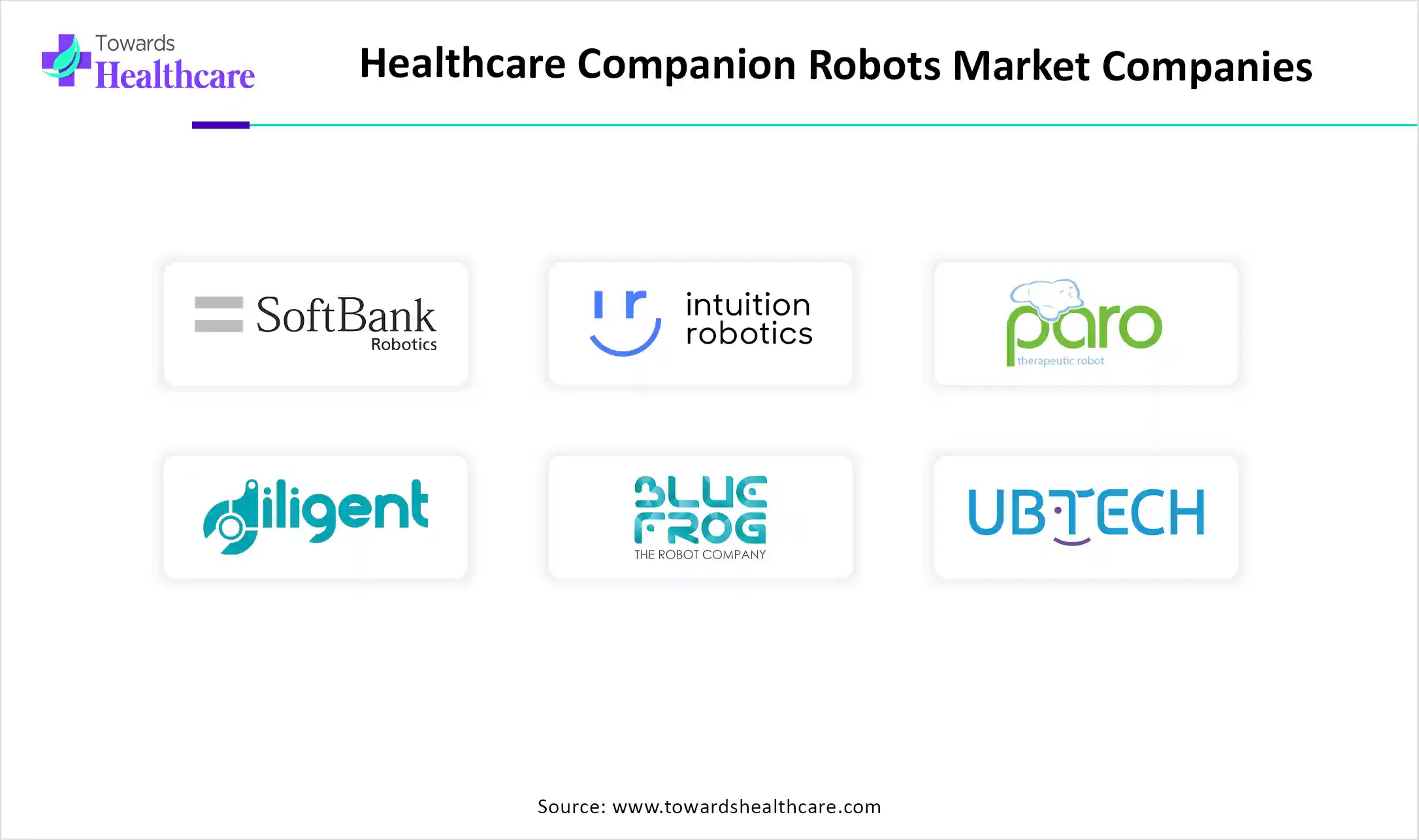Top Companies in the Healthcare Companion Robots Market

- SoftBank Robotics (Pepper, NAO)
- Intuition Robotics (ElliQ)
- PARO Robots U.S., Inc. (PARO Therapeutic Robot)
- Diligent Robotics (Moxi)
- Blue Frog Robotics (Buddy)
- Robot Care Systems (LEA Care Robot)
- UBTECH Robotics
- Hanson Robotics (Sophia, Grace)
- Toyota Robotics
- Jibo, Inc.
- GiraffPlus (telepresence robots)
- PAL Robotics (Ari, TIAGo)
- Furhat Robotics
- AIST – National Institute of Advanced Industrial Science and Technology (Japan)
- Fraunhofer IPA (Care-O-bot)
- Boston Dynamics (healthcare pilot use cases)
- iRobot (Roomba adapted for healthcare assistance)
- Kinova Robotics
- Robosoft Technologies
- Future Robotics Ltd.
Market Growth
The global healthcare companion robots market size stood at US$ 2.66 billion in 2024, grew to US$ 3.14 billion in 2025, and is forecast to reach US$ 13.92 billion by 2034, expanding at a CAGR of 18.04% from 2025 to 2034.
What are the Key trends in the Healthcare Companion Robots Market in 2024?
Collaborations Between Robotics Companies and Healthcare Providers: Partnerships with hospitals, clinics, and nursing homes enable robots to be tested, customized, and deployed in real-world care settings, increasing adoption and market reach.
- In September 2024, Japan’s Kanematsu Corporation partnered with Intuition Robotics to develop a Japanese version of the AI companion robot ElliQ, aimed at providing emotional support, cognitive stimulation, and wellness assistance to older adults. Kanematsu’s investment helped Intuition Robotics raise total funding to $85 million. ElliQ, designed without a human-like face, proactively engages users, remembers interactions, and encourages daily activities, offering a more interactive and supportive experience than traditional chatbots.
Advancements in AI and Robotics: Integration of AI, machine learning, NLP, and emotional recognition enables robots to provide personalized care, understand emotions, and interact effectively with patients, enhancing adoption.
- In January 2025, South Korea’s WIRobotics launched its wearable gait-assistance exoskeleton, WIM (We Innovate Mobility), in the U.S. Designed for seniors and patients recovering from lower-body injuries, WIM offers multiple modes: assist, resist, hike, and slow walk, and connects to an AI-powered app that analyzes gait and customizes exercise plans. Studies show it can improve speed, endurance, and lower-body strength by up to 78%. WIRobotics also provides WIBS, an unpowered back-support wearable robot.
Healthcare Companion Robots Market Value Chain Analysis
- R&D- R&D in healthcare companion robots is centered on combining AI, machine learning, and advanced sensors to deliver personalized care, emotional support, and assistance with daily activities and medication, particularly for elderly users.
- Patient Services- AI-driven healthcare companion robots support patients by managing medications, guiding daily activities, and recommending exercises. Unlike industrial robots, they are designed to recognize human emotions and offer psychological and emotional assistance.
- Distribution- Healthcare companion robots are distributed through hospitals, nursing homes, and rehabilitation centers, as well as directly to consumers for home use, using online platforms and collaborations with medical device distributors.
Latest Announcement by Industry Leaders
In August 2025, Chinese robotics firm Fourier introduced GR-3, its first full-sized humanoid care robot, designed to combine functionality with emotional engagement. Fourier emphasized that GR-3 aims for genuine human acceptance, featuring a lifelike, soft design and an emotional processing system that integrates vision, audio, and touch. The robot can recognize faces, maintain eye contact, and respond to touch with micro-expressions. GR-3 supports social companionship and assistive care, with potential future roles in mobility support, health monitoring, and rehabilitation. Fourier stated, love above all functionality guides its design, bridging mechanical utility and emotional connection.
Recent Developments in the Healthcare Companion Robots Market
- In March 2024, Franka Robotics introduced the Franka AI Companion, a robotics tool with advanced human-like tactile abilities. Designed to assist robotics researchers, it enhances research productivity and fosters innovation, representing a significant advancement in robotics technology.
- In January 2024, Intuition Robotics unveiled ElliQ 3, an upgraded AI companion for seniors integrating generative AI to enhance daily interactions. Supported by $25 million in funding, the improvements include advanced hardware and software, expanding ElliQ’s accessibility. The updates aim to boost autonomy, improve well-being, and reduce isolation among older adults, marking a significant step forward in human-AI companionship for senior care.
Become a valued research partner with us, please feel free to contact us at sales@towardshealthcare.com

